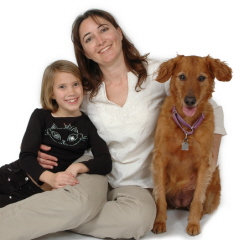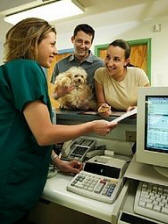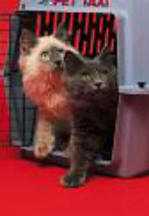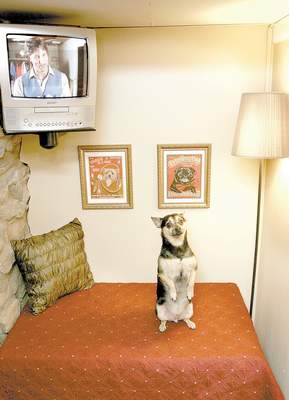More people travel between pre-Halloween
parties and Valentine's Day than during the
rest of each year and when they do, it
increasingly includes that beloved family
member, the
|
10 Essential Pet Items
1. Recent
Photo (in case pet is
lost).
2. Vaccination and/or
Medical Records
3. Any meds your pet
needs.
4. Leash
5. Water Container
6. Pet's usual dietary
food.
7. Familiar blanket
8. Favorite toy
9. Necessary cleaning
supplies
10. First Aid Kit if
needed at home
(thermometer, heating
pad, ice pak) |
|
pet.
Furry friends can use a little travel plan
of their own, so says the Travel Industry
Association of America who maintain 29
million of us who take our buddies along.
These days, travel can be more stressful for
Americans than it once was, so preparation
is of key import.
It helps to Know before you
Go
·
Pets, like people, should be fit, a Vet
check up is a good idea.
·
Pets, like people, sometimes get confused
and/or lost. You can at least help an awful
situation by making certain your best friend
wears an up-to-date ID tag at all times even
if you'd already gone the 'chip implant'
route.

Road Trips
·
Auto travel is outstanding for pets used to
riding in a car. For those not so fortunate,
even a few short rides prior to the real
trip, can help alleviate anxiety. Anyone who
has not been riding in a car for some time
realizes the sight of landscape passing by
causes a dizzy disoriented feeling to the
brain and the stomach, at least at first.
·
Regardless of where your pet is in the
vehicle, and this cannot be emphasized
strongly enough, proper ventilation and
temperature control is critical. Animals are
unable to handle freezing cold and suffer
heat stroke faster then people because of
their smaller body size.

·
When the car is moving, pets are safer in a
carrier, crate, or the ever popular car seat
with safety seat belt. (Skittish pets may
distract a driver.)
·
Pets familiar with car rides allowed to move
about freely should be kept away from areas
where air bags can be deployed in case of
accidents.
·
Just like us, pets need to relieve
themselves at regular intervals so
consideration for their needs makes you a
kind, considerate, responsible person.
Commercial Air Travel
·
Each airline has its own set of regulations
and most are at least somewhat different
from each other so check policies of your carrier
first thing.
each other so check policies of your carrier
first thing.
·
You are almost assured to need a Vet health
certificate. Even if one isn't demanded, it
is a good idea to get one.
·
Arranging your flight to take place during
off-peak traffic periods such at pre-dawn or
late nights means less airport/airline
crowding and confusion. This equates to less
stress for everybody, including you and your
pet.
·
When your flight schedule includes a layover
tell the ticket agent you need one with
enough time to take your pet outside for a
short walk so it can be allowed to relieve
itself.
·
Most airlines will allow cats and dogs small
enough (up to 15 lbs) to ride in carriers
that fit under the seat in front of you.
·
Keep a leash with you; upon landing, all
animals must be removed from carriers at
airport security checks.
·
Anticipate paying a pet travel airline fee,
anywhere from $60 to $200. Fees usually
depend on size and weight of pet as well as
the carrier crate.
 ·
Air Travel Safety crates can be purchased at
most local pet stores for a fraction of the
prices airlines sell at. Some show up on
Internet sites offered by people who used
but no longer need them. Try Craig's List -
it covers even different cities than your
own. Read Personal Ads in your town
newspaper, or eBay.
·
Air Travel Safety crates can be purchased at
most local pet stores for a fraction of the
prices airlines sell at. Some show up on
Internet sites offered by people who used
but no longer need them. Try Craig's List -
it covers even different cities than your
own. Read Personal Ads in your town
newspaper, or eBay.
·
Larger pets who must ride in cargo should
have crates brightly marked "Live Animal" on
top, bottom, and all sides.
·
Place firmly attached large photo of your
pet on top of crate.
·
Crate door should be clearly marked in large
letters, "Do Not Open without Owner or Vet
Permission".
·
Add some item your pal is familiar with when
putting your buddy in the crate, a favorite
toy or blanket, for stress reduction.
·
Avoid chew items that could get caught in
their throat during air turbulence.
·
Tranquilizers are a bad idea, always. Air
pressure and temperature changes affect all
life including our own, drugs are very
risky.
·
Inform your plane Captain and flight crew
that you have a pet onboard. Always. You are
paying for your pet to be cared for.
Hotel Stays
 ·
A number of websites offer rapidly
increasingly longer lists of pet friendly
hotels and motels. Phone ahead to make
certain your pet is as welcome as yourself.
·
A number of websites offer rapidly
increasingly longer lists of pet friendly
hotels and motels. Phone ahead to make
certain your pet is as welcome as yourself.
·
When checking in, ask which areas of the
facility are off-limits to your furry pal,
find out where he or she is welcome.
·
Ask for a ground floor room if possible. A
room away from much foot traffic is ideal,
for your hearing-sensitive friend and your
own good night's sleep undisturbed by doors
opening and closing in the middle of the
night.
·
Toss a sheet over any furniture likely to be
affected by your pet, especially in hot
weather when at the height of shedding that
winter fur coat.
·
Keep your pet on a leash outside your own
room.
·
During wet or snowy winter weather being
courteous by wiping your pet's feet as you
re-enter the building makes you a truly
welcome guest.
·
When leaving your pet alone in the room turn
a radio or TV on, volume low so your buddy
doesn't feel alone.
·
Hang the "Do Not Disturb" sign on the door
as you leave so a pet is less likely to be
alerted by housecleaning or some stranger
knocking.
·
Be prepared for change in your own plans in
the event of excessive barking.
·
When taking your pet with you be aware only
those wearing "Service Dog' tags or patches
are allowed in dining or pool areas.
·
Any scratching, chewing, or other violation
to the room, any damage should be promptly
reported to the desk clerk. It will be
discovered anyway. You are better off to
acknowledge and offer to make good on it. We
all are. That way we all remain
pet-friendly-welcome next time around.